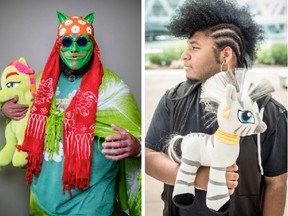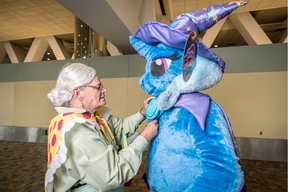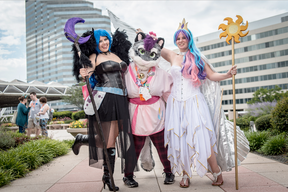Must Be Debt My Interest Is Growing Funny
Bronies explained: The grown men who love 'My Little Pony' aren't who you think they are
A Bronycon is the ultimate safe space: When you're in a rainbow wonderland of fellow travellers wearing unicorn horns and randomly hollering catchphrases like 'Fun! Fun! Fun!'

Reviews and recommendations are unbiased and products are independently selected. Postmedia may earn an affiliate commission from purchases made through links on this page.
More than half a decade into the Brony phenomenon, the grown men who love "My Little Pony" understand that the world remains curious about them. So they kicked off their recent Bronycon gathering in Baltimore with a crash course on dealing with the media, from which a couple helpful pointers emerged:
– Don't use jargon like "OC" or even "original character." Simply explain that the Pony-inspired name you go by in Brony circles is, for example, "Champ Romanhoof," the persona claimed by Chaim Freedman, a 17-year-old Brony from New Jersey.
– Do ask for their credentials. Certain publications of a conservative bent have been quick to smear Bronies. You'll never be able to convince these kind of journalists that Bronyism is an not a weird sex fetish, nor a sad childhood hang-up, but just another earnest, all-American fan community.
– Do talk up the narratives you'd like reporters to work into their stories, such as the money Bronies raise for charity. "The media," emphasizes Jake, the leader of this seminar, "is not the enemy."
Jake is a communications specialist for the Army with a stuffed Pinkie Pie toy perched on his shoulder, which perfectly complements his camo-toned biker vest. Like many people in this room, Jake has gotten his fair share of flak for loving a kids' cartoon inspired by a cheesy plastic toy marketed to little girls during the Reagan administration. (Once, he says, he was quoted in a story that complained of Bronies' body odour.)
But no one's in a defensive crouch here. A Bronycon is the ultimate safe space: When you're in a rainbow wonderland of fellow travellers wearing unicorn horns and technicolor manes, randomly hollering catchphrases like "Fun! Fun! Fun!" and singing fan-written songs with titles like "Mane Squeeze," you can stop worrying about what's normal and what's weird or where you fit in.
Unless it's a point of pride.
"We are the weird kids!" one audience member shouted out during Jake's seminar.
"It's our job to tell the Brony story," says Jake, "and I think the Brony story is worth telling."

There are a couple Brony stories, actually.
Forget your 1980s flashbacks. Yes, it's true that indirectly, this all started when the U.S. toy behemoth Hasbro birthed a new trinket — a hard-plastic equine with doe eyes and brushable nylon mane and tail — that became a birthday party sensation and inspired a saccharine Saturday morning cartoon.
Bronyism is not about that "My Little Pony."
Bronyism is specifically about "My Little Pony: Friendship Is Magic," a cartoon reboot that emerged in 2010, with vague similarities to the classic but an entirely new sensibility. It was launched by Lauren Faust, an animator with solid feminist-hipster credentials, who had grown up loving the original, but clearly wanted to propel it into the new century.
These pony characters are more like real people than some real people I know.
She introduced new characters like Rarity, a prima-donna unicorn with busybody tendencies; wry story lines, such as the one in which a male pony dresses as a female to get more attention; and celebrity cameos ("Weird Al" Yankovic voiced a character named Cheese Sandwich). Even outside the fandom, grown-up critics warmed to the show. Writing for the A.V. Club in 2011, Todd VanDerWerff called it "legitimately entertaining and lots of fun," citing the stylish animation, fresh humor, surprisingly complex story lines and relentlessly cheery vibe.
Still, it was solidly marketed as a kid's cartoon, even if one peppered with more than a few gags for mom, dad and the older siblings.
We may never know who, exactly, was the first Bro to discover the Pony. But early in the show's run, pictures of the show's star, Twilight Sparkle, with her squad, the Mane Sis, started materializing on the message board 4chan. Soon, the images became so plentiful that a separate message board was created for them, according to Jose Castillo, Bronycon's head of social media and press.

Nathan Hall, a 29-year-old Brony from Rockville, Maryland, saw these posts and didn't know what to make of them. But one night, he gave it a shot.
By the early morning, he had galloped through all 10 episodes that had aired thus far.
Later, he forced a friend to watch one episode. As the credits rolled, "the man turns to me and asks, 'Where's the next episode?' " Hall recalls.
It's pretty much the archetypal Brony origin story, which consists of five steps:
Skepticism: When a Brony-to-be first hears of the show, he can't comprehend how it could possibly be worth his time. Still, he's curious to know what the fuss is about.
Exposure: Boredom, drunkenness, a dare or the loss of a bet spurs the pre-Brony to watch an episode or two.
Addiction: Before he knows it, he has watched the entire series. It's something about the writing, the humour, the sophisticated themes. He can't get enough.
Evangelism: He tells his incredulous friends, who pass through the first three stages.
Bronyhood: Next thing he knows, he's calling himself "Boogie Hooves" and wearing fake ears or hooves or a pony onesie (or all of the above) at Brony gatherings all over the world.
To the uninitiated, sure, Bronies can seem a little out there. But ultimately, they're a subculture like any other — no weirder than your average Trekkie. Bronycon, with its costumes and games and meet-and-greets with MLP luminaries, simply fills a tighter niche than Comic Con, the San Diego geek gathering that long ago went mainstream.
And yes, Bronies are a bit nerdier. And perhaps a little sweeter.
"These pony characters are more like real people than some real people I know," says Bret Mix.
He's a 45-year-old man who has come to Bronycon with his 39-year-old wife, Amy, a first-timer, and their 11-year-old daughter, Autumn, who is dressed as Luna, the dark-blue reformed antagonist of Season 1. Autumn says watching "My Little Pony" and attending Bronycons have taught her to embrace diversity and make friends with all kinds of people.

In fact, the fratty overtones of the "bro" prefix are misleading. Roughly 20 per cent of Bronycon attendees identify as women — they're often called "Pegasisters." The founder of Bronycon is a transwoman, Jessica Blank, who goes by "Purple Tinker" in these circles; the convention offered all-gender restrooms.
And most attendees seemed sincerely devoted to a very deep reading of the conflicts and dynamics lurking within these two-dimensional horses. Ask a fan what "My Little Pony: Friendship Is Magic" is really about, and you'll get a slew of theories — gender identity, social norms, queerness, mental illness.
Ask Cadejo Jones about the character of Luna. He'll tell you that she is an all-too-compelling metaphor for addiction.
And she saved his life.
It was an episode from Season 5, "Do Princesses Dream of Magic Sheep?" A giant smoke monster called the Tantabus has invaded the ponies' dreams, merging them into one mass nightmare. But as the Tantabus prepares to breach the waking world, a teary-eyed Luna confesses to the Mane Six that she herself created this monster to punish herself for all the harm she previously inflicted upon the land of Equestria. Twilight Sparkle tells Luna to forgive herself — and when she does, the Tantabus disintegrates.
-
All-ages show: Hipsters love children's programming
-
The immersive escape game phenomenon gets new life by plunging players into the real world
-
Video game concerts unite players, bringing small screen emotions to big screen celebrations
Jones needs a moment to compose himself after showing this clip to a solemn and respectful Bronycon audience. He explains that the episode crystallized everything he needed to realize about getting sober; it pulled him back from the brink of suicide.
But it wasn't just the show that pulled him out of darkness. His fellow Bronies did, too.
"Bronies care," he says.
In another session, sociologist Brian Newby listened with interest as one Brony after another lined up to explain how "My Little Pony" has helped them express their own identities. One says it helped her come to terms with her gender fluidity; another says it helped her accept her own disability.
"How many people feel that in this fandom, you've found your people?" Newby asks. Almost everyone in the room raises their hands.
To wrap up, panelist and blogger Taylor Ramage asks if it's okay to lead the group in song. Music is omnipresent at Bronycon, with songs from the show plus fan-made music playing around every corner.
This song is a little different. She asks the audience if they know the song "This Little Light of Mine." They nod enthusiastically. Ramage explains that their song simply replaces "little light" with the words "cutie mark." In MLP, the ponies receive cutie marks — symbolic representations of the pony's personality — on their flanks in adolescence.
They sing: This cutie mark of mine, I'm gonna let it shine.
This cutie mark of mine, I'm gonna let it shine.
This cutie mark of mine, I'm gonna let it shine.
Let it shine, let it shine, let it shine.
williamsfunge1991.blogspot.com
Source: https://nationalpost.com/life/bronies-explained-the-grown-men-who-love-my-little-pony-arent-who-you-think-they-are

0 Response to "Must Be Debt My Interest Is Growing Funny"
Post a Comment